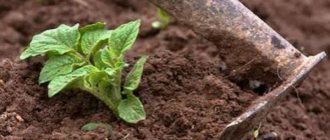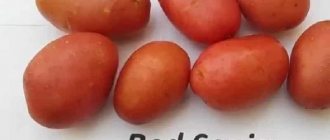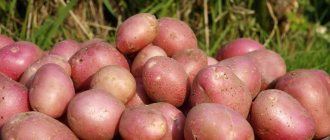Description
Arizona potatoes are classified as early table potatoes. The bushes are of medium height, with straight spreading stems. The leaves grow quite large.
Massive oval-shaped tubers gain an average weight of 110-150 g over the course of a season. The skin of the potatoes is yellow, and small eyes remain on the tubers. The pulp is light yellow (photo). The starch index corresponds to table varieties - 13-16%. The ripening period of the crop is 70-85 days. The Arizona potato variety is excellent for winter storage (keeping quality 95%).
Comparison with other varieties
This variety has a number of important advantages compared to others:
- Its peculiarity is that it has good resistance to pests and diseases. For example, high protection against golden nematode and potato cancer is known;
- Keeping quality, which is 95%, is a very high indicator. This potato variety is able to survive the winter with virtually no losses;
- High-quality commercial appearance can also be considered one of the advantages of the variety. If you buy it for a holiday table, it will delight everyone who tastes it;
- The variety has excellent taste;
- Since such potatoes hardly spoil when properly stored, they are suitable for transportation over long distances.
This variety of potatoes can be purchased not only in Moscow, but everywhere in Central Russia.
Landing
An important stage before planting the Arizona variety is the processing and germination of tubers. Select healthy, undamaged material. In order for the sprouts to grow faster, the potatoes are taken to a warm, well-lit place.
Important! The use of growth stimulants accelerates the germination of Arizona variety tubers and increases yield, increasing resistance to pathogenic microorganisms and harmful insects.
A common and popular remedy is “Epin”. Arizona potato tubers treated with the drug can withstand late frosts down to -5 C. The bushes grow more powerful and stronger, and the root crops ripen faster. For spraying, one ampoule (0.25 ml) is diluted in 400 ml of water. This amount is enough to process approximately 200 tubers. The procedure is carried out one day before planting Arizona potatoes.
A lighted place is allocated for potato beds. Non-acidic soil is preferable. Crop rotation is an important factor for obtaining a good harvest. Potatoes grow well after onions, cabbage or various greens.
The Arizona variety is planted in the first half of May - when the soil has warmed up sufficiently. The site must be prepared - loosened, weeds removed. On planting day, the soil is treated with a solution of potassium permanganate. Tubers are also sprayed with special means. Fungicide "Matador" will protect planting material from the Colorado potato beetle, wireworm, late blight, and Alternaria. Dilute 30 ml of product in 200 ml of water - this is enough to spray 30-35 tubers. To ensure high-quality processing, Arizona potatoes are laid out in one layer and sprayed first on one side and then on the other.
A little peat mixed with humus is added to holes approximately 10 cm deep. The row spacing is made 65-70 cm wide. And in the row, a distance of 25-30 cm is maintained between the holes.
Advantages and disadvantages of the Arizona variety
- The undoubted advantages of the variety include:
- High yield.
- Good taste and culinary properties.
- Large potato sizes and lack of small tubers.
- High percentage of shelf life.
- High commercial qualities - from 88 to 97% suitability for sale.
- Excellent transportability and long-term storage ability.
- Resistance to major potato diseases.
- The disadvantages of the variety come down to the following:
- Weak resistance to late blight of tops and tubers.
- Weak resistance to common scab.
Care
Arizona potatoes are quite unpretentious. However, following certain care rules will help increase productivity:
- for better potato growth, high beds are formed;
- after watering, the soil must be mulched;
- approximately 5-7 days before digging up the root crops, the tops are cut off.
The choice of irrigation regime is influenced by several factors: climatic features of the area, composition and structure of the soil. If rains are frequent, then there is no need to specifically water the Arizona potato plantings. It is better to loosen the soil regularly. Loosening is also called “dry watering” because it preserves soil moisture.
Advice! Arizona potatoes do not like sudden changes in humidity. Therefore, as soon as the foliage begins to wilt, all beds are carefully watered.
When growing the Arizona variety in any region, it is important to carry out agronomic practices and plant feeding in a timely manner.
Useful tips for gardeners
To get a good harvest when growing the Arizona variety, along with observing “academic” standards of agricultural technology, it would be useful to listen to the recommendations of experienced gardeners:
- It is better to plant Arizona during the waning moon . Many gardeners believe that planting work should be commensurate with the lunar calendar and, when the moon is waning, plant everything that grows downward - bulbs, root crops, including potatoes, and if the above-ground part of the plant is important, then plant when the moon is waxing.
- The combination of fertilizing and rolling down bushes is the most optimal.
- The need for additional watering is determined as follows: to do this, you need to lower your palm into the soil and, if the soil is dry below the level of your fingers, the potatoes should be watered.
- To protect the area from weeds and retain moisture, the soil needs to be mulched .
- On a bright sunny day, it is better to place the dug-out crop to dry under a canopy - this will protect the potatoes from burns.
We recommend that you learn how to dry potatoes after digging.
So, the Arizona potato variety is of high quality and easy to care for. If all agrotechnical standards are strictly followed, he is able to please with a quick and abundant harvest of tasty and culinaryly versatile potatoes.
Hilling and feeding
The first time hilling is carried out when the potato stems grow 15-20 cm high. The second time (after 2-3 weeks) the soil is carefully loosened and rolled onto the stems, forming mounds.
Important! Hilling up Arizona potatoes is carried out with damp soil. If dry weather sets in, hilling is done after watering.
What is noteworthy is that hilling is important when growing Arizona potatoes in regions with different climatic features. In dry areas, this technique will prevent the soil from overheating and help maintain soil moisture. And in places with cool and rainy weather, thanks to hilling, the earth will be loosened, which will ensure the flow of air to the root crops.
Fertilizer application
Experienced gardeners recommend feeding plants three times a season:
- As soon as Arizona potato shoots appear, nitrogen-containing compounds are applied. Pale foliage is a signal of nitrogen deficiency. You can use a solution: 500 ml of mullein and 15 g of urea are diluted in 10 liters of water. 500 ml of the mixture is poured under each bush.
- During bud setting, potassium-based fertilizers are applied. This will promote the setting and growth of tubers. In 10 liters, dilute 15 g of potassium sulfate and double superphosphate, half a glass of wood ash. For one bush, 500 ml of solution is enough.
- Approximately 20-25 days before digging the Arizona potato crop, a mineral-organic mixture is applied. For 10 liters of water take 30 g of superphosphate and a glass of slurry. For one bush, 50 ml of fertilizer is enough.
The best option is a combination of fertilizing and hilling the bushes.
Harvesting and storage
The first digging of Arizona potatoes can be done 2 months after emergence, i.e. already in mid-July. The main collection is planned for the end of the month or the first ten days of August. 2 weeks before this, the tops can be mowed down to 10 cm so that the tubers ripen faster.
To harvest, you need to choose a fine day without rain. The dug up tubers are laid out in a furrow and dried.
In winter, Arizona potatoes are stored in basements in boxes or bags at a temperature not exceeding +4 °C
Root crops are sorted and packaged in containers. First, keep in a cool room at a temperature of +15 °C. After 2–3 weeks, they are sent to the cellar, where they are stored at a temperature of +2–4 °C and a humidity of 70–80%. The largest and smallest, as well as damaged root vegetables, are best consumed first.
Diseases and pests
To obtain a voluminous and high-quality harvest, it is important to notice signs of disease in time and use the right means to combat dangerous insects.
Late blight (brown rot) easily affects the plant. In favorable conditions, when the weather is warm and humid, it quickly attacks the entire planting. The source of rot can be soil, infected tops, or affected neighboring plants (especially the nightshade family). The initial signs are darkening of the lower leaves on the bushes. The entire plant (aerial part and root system) is gradually affected. It is necessary to start fighting for the harvest when the first symptoms appear - planting is sprayed with fungicides: Skor, Ditan, Bravo, Reglon super. Preventive measures are of particular importance - the rules of crop rotation are observed, Arizona potatoes are not planted in the lowlands, thickening of the beds is not allowed, and bushes are hilled.
Common scab is a fungus that attacks the skin of tubers. The disease leads to the loss of presentation of Arizona variety tubers, the taste of potatoes deteriorates, the amount of starch decreases, and the shelf life of root crops is reduced. The disease develops in dry, hot weather. Control methods: use of physiologically acidic fertilizers (manganese sulfate, ammonium sulfate), culling of infected tubers during planting, regular soil irrigation (especially after the budding phase).
The Colorado potato beetle and its larvae eat the green part of the potato, which leads to the destruction of the bush. The insect overwinters in the ground and as soon as warm weather sets in, it comes to the surface. If your Arizona potato plantings are small, you can collect insects and larvae by hand. A more effective method is the use of biological agents. The beds are sprayed with Agrovertin, Bicol, Colorado. Popular folk remedies include treating bushes with a solution of birch tar (100g of the product is diluted in a ten-liter bucket of water), and an ash-soap solution.
Arizona Potatoes
Arizona Potatoes
One of the highest-yielding mid-early ripening potato varieties. The originator is Dutch. According to the State Register, it has the properties and characteristics listed below.
Culture:
Potato (Solanum tuberosum L.)
Year of inclusion in the register:
2013
Direction of use:
dining room
Ripening period:
mid-early
Plant type:
rn resistant to cancer, pathotype I and to golden potato nematode (R01)
Admission region:
Central, Central Black Earth, North Caucasian
Originator(s):
"AGRICO", POSTBUS 70, 8300 AB EMMELOORD NETHERLANDS
The potato variety "ARIZONA ®" is included in the State Register database for the Central Black Earth and Central regions of the Russian Federation.
Description
- The yield of the variety is high
- Table purpose
- Bush of medium height, leafy type, semi-erect to spreading
- The leaves are quite large, closed in shape, green in color
- The corollas of this variety range from large to medium in size.
- Tubers of the Arizona variety are large, oblong, oval with small eyes
- The marketable yield is quite high: 220-400 c/ha, on par with the Nevsky standard and about 200 c/ha higher than the Krasavchik standard. The maximum yield is close to 580 c/ha, 300 c/ha higher than the Elizabeth standard
- The weight of the commercial tuber is 112-150 g. The starch content is 13.0-16.0%. Number of tubers from 10 to 14 pieces per bush
- Disease resistance is average for tops and relative for tubers
- The Arizona variety has a yellow skin and light yellow flesh.
- Taste good
- Marketability 88-97%, keeping quality (quality of stored tubers) 95%
- Resistant to potato canker pathogen and golden potato cyst nematode
- According to the originator, it is moderately susceptible to the pathogen of late blight on tops and relatively resistant to tubers. Resistant to wrinkle mosaic
Harvesting
The tops are mowed approximately 7-10 days before digging up the tubers, which speeds up their ripening. It is advisable to harvest in dry weather. The best root crops are left for planting for the next season. Sick and damaged potatoes are thrown away.
In order for Arizona potatoes to dry, they are left on the field for 1-2 hours, provided the air temperature is not high. On a bright hot day, it is better to scatter the crop under a canopy, otherwise burns may appear on the fruits.
The Arizona variety is very popular due to its easy care and excellent growth at low temperatures.











